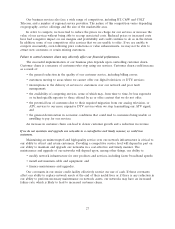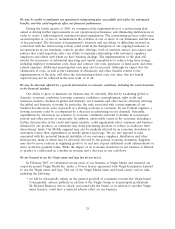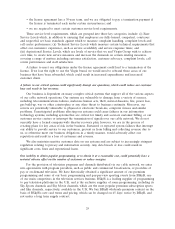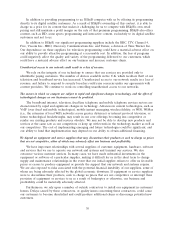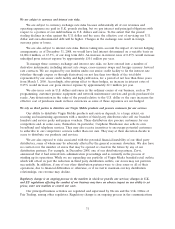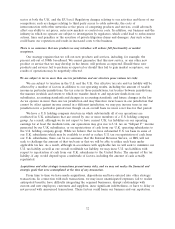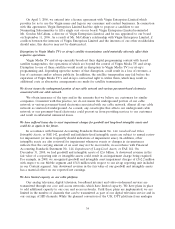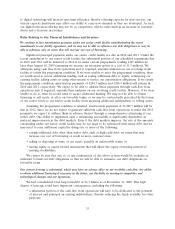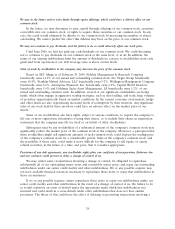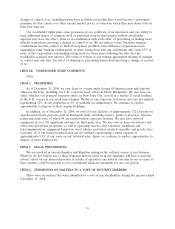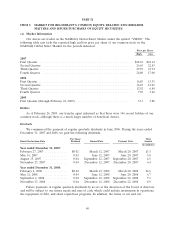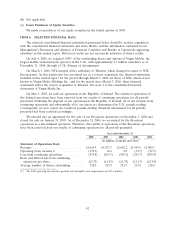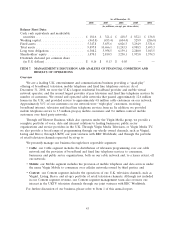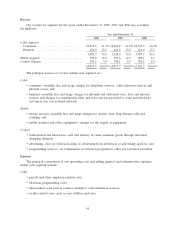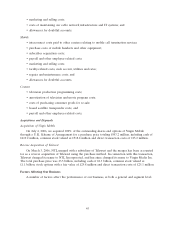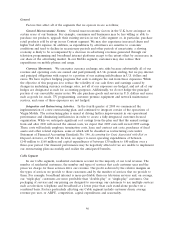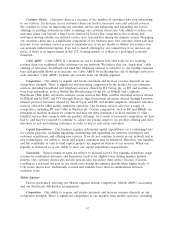Virgin Media 2008 Annual Report Download - page 39
Download and view the complete annual report
Please find page 39 of the 2008 Virgin Media annual report below. You can navigate through the pages in the report by either clicking on the pages listed below, or by using the keyword search tool below to find specific information within the annual report.subsidiaries to move cash within their restricted group. Applicable tax laws may also subject such
payments to further taxation.
Applicable law may also limit the amounts that some of our subsidiaries will be permitted to pay
as dividends or distributions on their equity interests, or even prevent such payments.
The inability to transfer cash among entities within their respective consolidated groups may mean
that even though the entities, in aggregate, may have sufficient resources to meet their obligations, they
may not be permitted to make the necessary transfers from one entity in their restricted group to
another entity in their restricted group in order to make payments to the entity owing the obligations.
Risks Relating to Our Common Stock
The market price of our common stock is subject to volatility, which will continue.
The market price of our common stock has been and may continue to be adversely affected by
conditions in the global financial markets, and stock prices of highly levered companies, in particular,
have been highly volatile. The market price of our common stock could also be subject to wide
fluctuations in response to additional factors, many of which will be beyond our control. These factors
include general economic and market conditions, such as a recession, market perception of refinancing
risk, actual or anticipated variations in our operational results and cash flow, our earnings releases and
our competitors’ earnings releases, announcements of technological innovations, changes in financial
estimates by securities analysts, trading volume, currency and exchange rate fluctuations, market
conditions in the industry and the general state of the securities markets and the market for
telecommunications stocks, changes in capital markets that affect the perceived availability of capital to
communications companies, governmental legislation or regulation and rumors of private equity interest
in our company. Trends in the telecommunications industry are likely to have a corresponding impact
on the price of our common stock.
In addition, in order to maintain the listing of our common stock on NASDAQ, we must remain in
compliance with NASDAQ Marketplace Rules, including but not limited to, minimum bid price
requirements. If we are unable to comply with these rules, our common stock may be delisted from
NASDAQ. Under the terms of our convertible senior notes, holders will be entitled to demand that we
redeem their notes at par value or to tender their notes for conversion if we fail to maintain a listing of
our common stock on NASDAQ or the New York Stock Exchange. NASDAQ has temporarily
suspended the minimum bid price requirement for continued listing on the exchange until April 2009,
and may extend this suspension based on then prevailing market conditions. In the event that our
common stock is delisted from NASDAQ, the market for our common stock may be limited and it may
be difficult for our stockholders to sell their shares at an acceptable price, or at all.
Conversion of our convertible notes will dilute the ownership interest of existing stockholders.
Any issuance by us of our common stock upon conversion of our convertible notes will dilute the
equity ownership interest of existing stockholders, including holders who have received shares of our
common stock upon prior conversion of our convertible notes. Additionally, our convertible notes
include anti-dilution and ‘‘make-whole’’ premium provisions that, if triggered, would result in an
increase in the number of shares of our common stock issuable upon conversion of the convertible
notes. Conversion of the convertible notes in circumstances where these provisions have operated could
have a significantly greater dilutive effect.
Sales in the public market of the common stock issued upon conversion could adversely affect
prevailing market prices of our common stock. In addition, the existence of the convertible notes may
encourage short selling by market participants.
37


